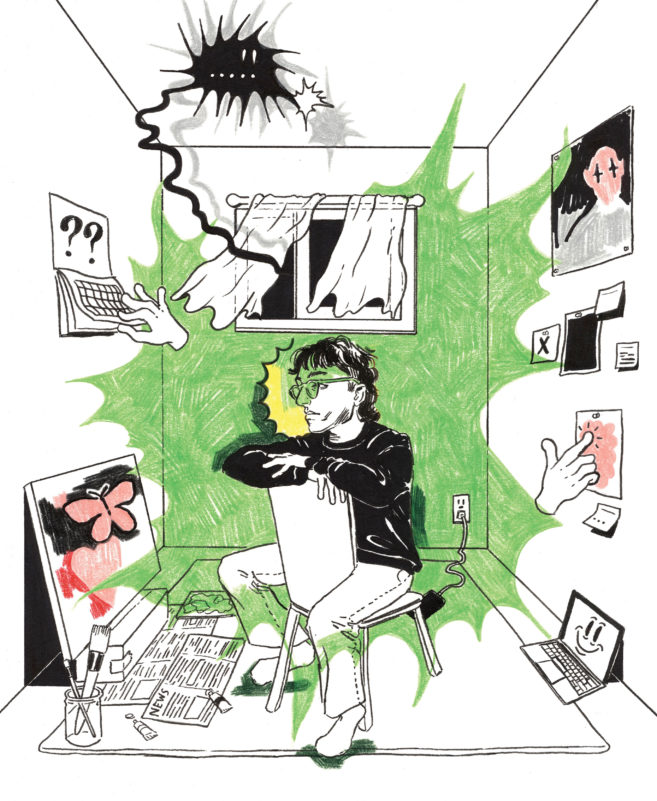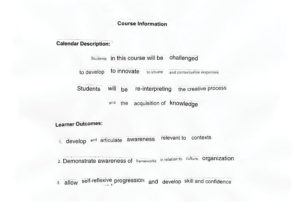Whether you’re a painter, a sculptor or photographer, you also have to be a writer. “The artist statement, or your mission statement, is a basic introduction to your art,” explains Business Skills for Creative Souls: The Essential Artist’s Handbook. This mission statement is often an essential part of applications and proposals for residencies, grants and exhibitions. Here are some tips to help you with this important exercise.
Build a research resource
Whether focusing on one class assignment or the development of your general practice, it’s a good idea to keep a notebook, scrapbook or sketchbook of everything that inspires you along the way. Attach articles and highlight important points. Write down moods your studio process brings up. Paste in images of artworks or artists that teachers suggest might relate to your production. Note descriptive words that you hear repeatedly from your peers regarding your work. Soon you’ll have a research resource that you can draw upon when writing your statement.
Tap into the power of revisions
It can be difficult to get anything written if we think the first draft has to be top-notch. A more effective (and efficient) method of producing strong writing is to tap into the power of revisions—let the first draft be the long, rambling, raw material it is for most writers. Then refine it into a second draft, and a third, and fourth, and a fifth, perhaps trying to trim it by a half or a quarter each time. With each draft, the final product will get more focused. Be prepared to revise your artist statement on an ongoing basis. “Your artistic vision or statement is not set in stone,” notes the Cultural Human Resources Council’s The Art of Managing Your Career, “so you can revise it as you gain more clarity. Even established artists rewrite their vision statements as their careers evolve and their values change.”
Be clear and concise
An artist statement can be a kind of short essay, and every essay needs a thesis. This thesis clearly identifies what you’re trying to do in a sentence or two. It also tends to work better when it is specific rather than vague. When you’re working on your thesis statement, ask yourself some questions: How can I make this more specific? Is there anything I’m leaving out? If you’re unsure how your message is coming across, have friend read your statement and see what feedback they have.
Remember less can be more
After reading the statements of other contemporary artists, one may feel pressured to use words or reference concepts one doesn’t completely understand. But it’s important to aim for honesty, and, again, clarity. Don’t force yourself to present a long statement if you can say everything you need to in a few paragraphs. Don’t reference something that isn’t actually relevant to your work. Choose your words carefully and don’t use big, unwieldy ones unless they actually express what you are trying to do. “With any piece of writing,” says Art Gallery of Ontario curator of contemporary art Kitty Scott, “I always advise being clear, concise and economical. If you don’t have anything to say, don’t say it.” That means keeping your statement to “about 150 words.”
Ask for help
You may have trouble figuring out what you want to say, or saying everything in just a few words. To help with this, The Art of Managing Your Career suggests working with a colleague, who can ask you questions and help you to make your statement clearer. In conversation with this colleague, you can you explain “what drives you as an artist, what excites you, who or what influences what you do, and how you think your work is unique or special.” You can also reach out to your learning institution. Most universities and colleges now have centres devoted exclusively to helping students with their writing. From customized workshops to one-on-one tutoring, these centres can be invaluable in helping to develop your artist statement stills—free of charge. Call or drop by to see how your writing centre staff can be of assistance with idea generation, editing, formatting and more.

 When working on an artist statement, it can be helpful to consult with friends, colleagues, or experts at a school writing centre. Photo: Facebook / Emily Carr University of Art + Design.
When working on an artist statement, it can be helpful to consult with friends, colleagues, or experts at a school writing centre. Photo: Facebook / Emily Carr University of Art + Design.







